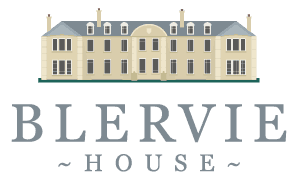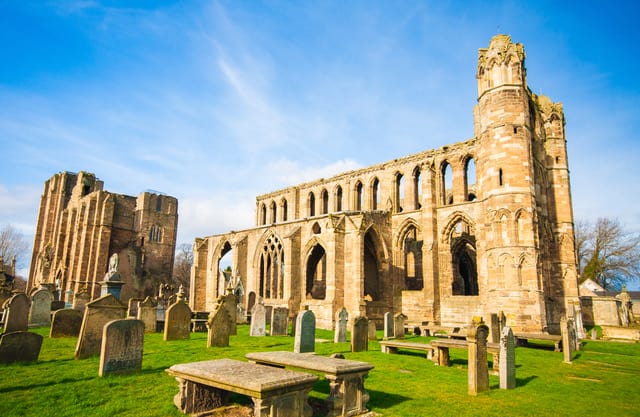E is for Elgin – Nestled in this world-famous whisky region, Elgin lies on the south coast of the Moray Firth, roughly midway between Inverness and Aberdeen and straddles the River Lossie.
Once associated only with royal palaces and cathedrals, Elgin is now the centre for luxurious cashmere production and world-famous whiskey distilleries, and it is also our closest town for shopping.

Elgin was first recorded in 1151 and was a famous home for early Scottish monarchs. The town offers many pleasant characteristics, breathtaking scenery and several local distilleries, including Glen Moray and the headquarters of Gordon & MacPhail.
On North College Street is the lovely ruin of Elgin Cathedral. Once considered Scotland’s most beautiful Cathedral, rivalling St Andrews in importance, today it is little more than a shell, though it retains its original facade today. Unusual features include the Pictish cross-slab in the middle of the ruins and the cracked gravestones with their memento mori of skulls and crossbones.
 It is impossible to appreciate the importance of this Cathedral and the influence of the Church without visiting the inside of this incredible building. Inside, you are given a glance at what the Cathedral must have looked like in all its original glory, and you will be astounded. The restoration of the colours on some of the original plasterwork is stunning, and so is the quality and structure of the building.
It is impossible to appreciate the importance of this Cathedral and the influence of the Church without visiting the inside of this incredible building. Inside, you are given a glance at what the Cathedral must have looked like in all its original glory, and you will be astounded. The restoration of the colours on some of the original plasterwork is stunning, and so is the quality and structure of the building.
 Next door to the Cathedral and unmissable during your town visit, you will find Johnstons of Elgin. This family-owned business, which has been in operation for some 224 years, is a treasure trove of Scottish luxury, with muted tweeds, cashmere throws, heritage visits, and original buildings.
Next door to the Cathedral and unmissable during your town visit, you will find Johnstons of Elgin. This family-owned business, which has been in operation for some 224 years, is a treasure trove of Scottish luxury, with muted tweeds, cashmere throws, heritage visits, and original buildings.
That said, enjoy a walk or drive around Elgin and appreciate the building of the classic Scottish Granite house. Some beautiful buildings, such as Thunderton House, previously a Royal Palace, played host to Bonnie Prince Charlie in 1746. Throughout the town, you will find information linking the town to the infamous Wolf of Badenoch, responsible for the destruction of both Elgin and the Cathedral, and whose name you will encounter throughout Scottish history.
While in the town, take the time to visit either the Visitor Centre or take a tour of the Glen Moray Distillery. The visitor centre always has a fantastic selection of Whiskies and Whisky flavoured treats that I find hard to go without, and the cafe is highly recommended. The smell of malted barley lingers in the air as you overlook the extensive bonded warehouses of this lovely local distillery.
 On the outskirts of the town, you will find Spynie Palace. Again, linking back to the original influence of the Church prior to the Cathedral being built in 1224, this is an overlooked gem of Scottish history that plays its part in Elgin’s history.
On the outskirts of the town, you will find Spynie Palace. Again, linking back to the original influence of the Church prior to the Cathedral being built in 1224, this is an overlooked gem of Scottish history that plays its part in Elgin’s history.
 One of the best ways to reach Elgin from us is to turn right out of the Blervie House and drive through Pluscarden Valley, enjoying the scenic vista of forest, farmland, distilleries, and moorland that opens up in front of you until you see the town laid out in front of you. Easily recognised by the Duke of Gordon’s monument, some 24m high, standing on Lady Hill, it is a most impressive site overlooking the town.
One of the best ways to reach Elgin from us is to turn right out of the Blervie House and drive through Pluscarden Valley, enjoying the scenic vista of forest, farmland, distilleries, and moorland that opens up in front of you until you see the town laid out in front of you. Easily recognised by the Duke of Gordon’s monument, some 24m high, standing on Lady Hill, it is a most impressive site overlooking the town.
Like so much of Scotland, some of the best aspects of an area are exploring its immediate surroundings, and the area around Elgin offers lovely opportunities for that.
A lovely drive-through scenery, stunning historical ruins, a world-famous distillery, and a Cashmere producer by Royal Appointment make for a relaxing and memorable day out.



